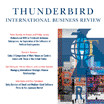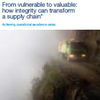 Another month has passed, and it’s time for another dive into the blogosphere. This month’s blog is a blog for anyone who works with or is exposed to risk, and it’s a blog full of personal insights, funny stories and profound wisdom. Slightly belated, due to the recent arrival of my baby daughter, which is why I am now a bit behind on my blogging let alone sleeping routines, this month’s blog review is a tribute to one of my most faithful Twitter followers and re-tweeters, Nicholas Hawtin of riskcontainment.com. Hardly a post on husdal.com goes by without Nicholas retweeting it, and often more than just once, thus bringing a steady flow of visitors to my blog. Nicholas, I owe you one, and this post is my Thank You for helping this blog reach its audience. Hopefully I can do the same for you, by promoting you on husdal.com.
Another month has passed, and it’s time for another dive into the blogosphere. This month’s blog is a blog for anyone who works with or is exposed to risk, and it’s a blog full of personal insights, funny stories and profound wisdom. Slightly belated, due to the recent arrival of my baby daughter, which is why I am now a bit behind on my blogging let alone sleeping routines, this month’s blog review is a tribute to one of my most faithful Twitter followers and re-tweeters, Nicholas Hawtin of riskcontainment.com. Hardly a post on husdal.com goes by without Nicholas retweeting it, and often more than just once, thus bringing a steady flow of visitors to my blog. Nicholas, I owe you one, and this post is my Thank You for helping this blog reach its audience. Hopefully I can do the same for you, by promoting you on husdal.com.
Nicholas Hawtin
Nicholas describes himself as half Danish, half English and half American – shouldn’t that be one third each? – a fan of smart risk-taking, especially in tech, startups, and firms that dare to think differently, with a broad experience in project and risk management in highly challenging situations across many different industries, countries and cultures. He is a man that likes asking the uncomfortable questions and helping people seize the opportunities risks present, and it shows throughout his blog.
riskcontainment.com
Today’s blog is a blog for anyone who works with or is exposed to risk, and it’s a blog full of personal insights, funny stories and profound wisdom. Actually, it is much less about risk than about anything else, and business and management insights told through a personal lens and seen in light of past and present events, coupled with a solid dose of risk understanding is perhaps a more fitting description. Whichever way I look at it, I always have a great time reading Nicholas’ posts.
Blog Highlights
Here are some samples of what you can find on riskcontainment.com:
In his most recent post, The Long Drop from Nokia’s Burning Platform, Nicholas compares Nokia’s current struggle for survival with the Alexander Kielland disaster, the worst offshore catastrophe in Norwegian history ever, when an oil rig capsized during a severe storm in 1980, killing 123 of the 212 on board. Although still in my teens at that time I vividly remember the TV news from back then.
Modern rigs have specialized lifeboats whose seats have fire point harnesses and head straps. The drop is long and the landings dramatic. If you don’t make it to a boat, you either stay and burn or do the drop alone in what you’re wearing. Nokia’s CEO chose that choice to indicate the severity of the firm’s position and stir his staff into action. Time will show how many people make it off Nokia’s platform – and how many of them get picked up.
That is quite a long way from how Nokia beat Ericsson in 2000, in the now classic case of how to and how not deal with a supply chain disruption that I wrote about in the early days of this blog.
In Raspberries Happen, perhaps paraphrasing a more renown (or rather infamous) phrase, Nicholas reflects on some blogging mishaps, when his raspberry logo disappeared and what he did about it.
Raspberries happen. What you do about them is up to you. You can spend a long time fixing a problem or you can do it quickly and effectively. Your choice often depends on how much you enjoy the finger-pointing and recriminations portion of the process.
Sounds familiar. I had my own raspberry happen to me not too long ago, when I tweaked my blog to the point where it broke, and then struggled for hours in vain at getting it back until I realized that my web host had a backup and restore feature that I had completely overlooked and wrote about in A blog continuity lesson in practice. And perhaps similar to what Hawtin wrote in Back Up? What Back Up?
In What Do You Need To Know? Hawtin reflects on “information overload” and how management must communicate clearly what it is that they need to know in order to obtain what they are looking for, not what everyone thinks they are looking for.
Soldiers love their acronyms and the more convoluted, the better. ”Commanders Critical Information Requirements”, or CCIR, is a mouthful, but still decipherable as “What the Boss wants to know”. It’s one of those military ideas worth copying. It is a perfect example of an entire organization knowing management’s information needs. Many civilian organizations manage to communicate their general priorities, but few achieve military clarity in collective information-seeking.
Excellent point. And perhaps something to consider when looking at what I said about supply chain visibility.
When he is not blogging, Nicholas acts as a mentor at startupbootcamp.org, a European accelerator programme for business startups, and many of his posts reflect on the risks, uncertainties and opportunities that startups present. In The Yoko Ono Factor he gives good advice to startups that break up in the early phases of their venture:
Absurd as it may sound there are still people who see any attempt to leave as treason and fight anyone trying to go. Others deny that it has any effect, believing that one person is good as the next. Others freeze, doing nothing as people walk away. All three have their flaws and fortunately there is an alternative. Accept that people come and go – and think through how to deal with it. Break ups can get complicated – especially if you’re not prepared. Like marriages, nobody goes in expecting to quit, but committing to a job, especially in a start up does not mean you have to accept all the risks unaltered. Going in, most of the discussion about expectations is focused on the positive, the things everyone wants to happen. It is worth thinking about what your expectations are if things do not go as hoped – and specifically if someone wants to leave.
This holds true for any organization, start up or no start up. My post on What do do when key personnel leave? has a similar story.
Conclusion
Thought-provoking at times, and always full of insights worth reflecting upon, riskcontainment.com is a fun blog to read, and indeed a great addition for anyone who works with or is exposed to risk. For the WordPress geeks among my readers, you may be interested to know that both Nicholas and I are using the same blog theme, albeit it may not be apparent at first glance, thanks to the versatility of the Atahualpa theme.
Links
- riskcontainment.com: Keep calm
- linkedin.com: Nicholas Hawtin
- twitter.com: @RiskContainment
Related posts
- husdal.com: Blog Review: SCRMBlog












